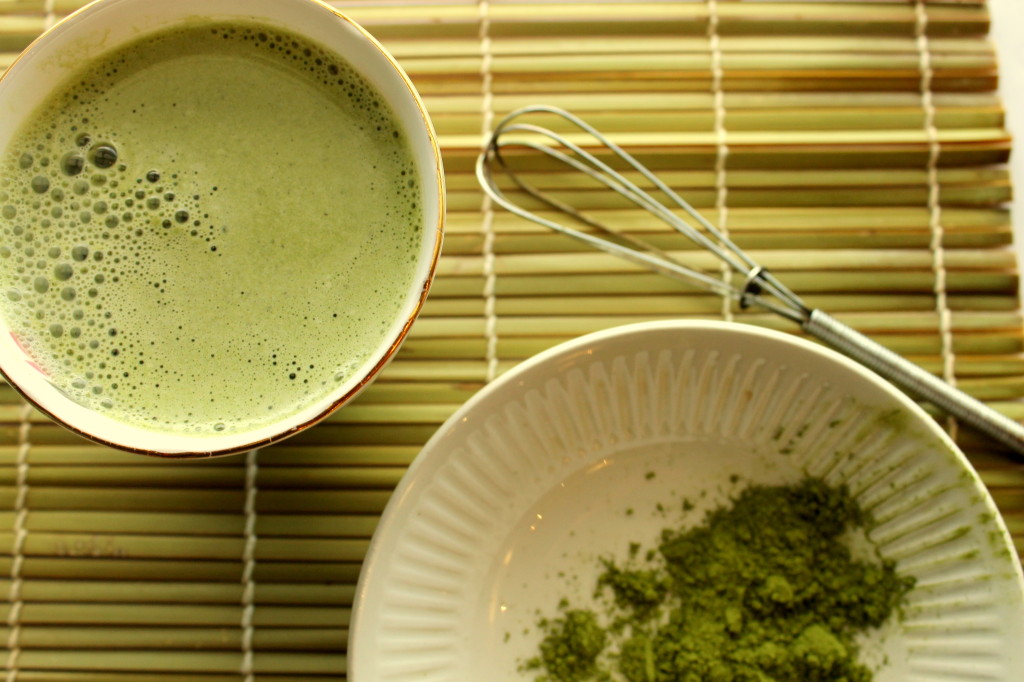This post originally appeared at thenakedlabel.com
I feel sort of sneaky. Here I am at Starbucks using their free Wi-Fi and electricity while simultaneously writing this article about the sneaky ingredients in their matcha green tea soy latte!
I used to love Starbucks and would feel really comforted finding one while traveling. I have fond memories of sipping match green tea lattes in Seoul and basking in the comfort of a ‘home’ away from home. I brought this tradition back with me when I returned to Toronto thinking I was being nutritionally savvy: I kept thinking antioxidants + green leaves = healthy. Boy was I wrong!
Flash forward a few years: I finally started thinking about my matcha green tea lattes. When I would purchase it at other cafes in Toronto, the matcha lattes would look less green and tasted much less sweet. At Starbucks, I would always order my latte without syrup and with organic soy milk but they were still sweeter. The baristas always assured me that the matcha powder used was pure and my drink was ‘unsweetened’.
After some research I found that the matcha powder used at Starbucks did in fact contain sugar and a lot of it. Mon Dieu! That stopped me from having lattes at Starbucks because of what else I found out. Beyond the obvious surge of sugar I was having after consuming the matcha latte I was also having some other questionable ingredients!
What’s Really in My Matcha Latte?
Recently I called Starbucks to find out what was in that latte since it had been years since I had one. The representative I spoke to looked up the ingredients in the matcha powder. He said it contained sugar, flavoring, matcha, and green tea leaves (ok, by definition matcha is pure powdered green tea leaves). As for the sugar and flavoring, those are red flags for me as a holistic nutritionist. Oddly, when I went to a Starbucks café in person to look at the package first hand it said it contained sugar and Japanese green tea. Strangely, the representative on the information line said it contained flavoring too. Regardless, with all the confusion the Starbucks matcha powder still isn’t healthy.
I used to think of having my Starbucks Matcha Green Tea Latte as a healthy habit but if we look at traditional Japanese culture in which matcha tea was used ceremoniously we see that it was consumed only at special times. This makes sense as green tea contains a high amount of naturally occurring fluoride. Fluoride has been linked to thyroid issues, neurotoxicity and other issues so regular consumption may not be the best idea. Especially if 1 teaspoon of matcha powder is equivalent to about 10 cups of green tea. Everything in moderation. Just because a food is ‘healthy’ doesn’t mean it should be consumed all the time. Variety is key.
Ingredients in a Starbucks Matcha Soy Latte
Matcha: ground up green tea, sugar, flavoring, matcha
Simple syrup (optional): sugar, water, citric acid (E330), Preservative: Potassium Sorbate (E202)
Soy milk: filtered water, whole organic soy beans, organic evaporated cane juice, calcium carbonate, sea salt, carrageenan, sodium citrate, organic vanilla flavour, sodium bicarbonate, natural flavour, zinc gluconate, vitamin A palmitate, vitamin B2, riboflavin, vitamin B12
Do we really need all the extras? The 6 Questionable Ingredients!
1. What’s up with all the SUGAR?
According to Starbucks’ nutritional data their matcha lattes range from 20g-59g of sugar depending on the size. That equals roughly 3.3 – 10 teaspoons of sugar in a single drink! While sugar is a component of whole foods such as fruits, having sugar in a processed, isolated form can be detrimental to the immune system, pose a factor in cardiovascular disease, upset insulin levels, create hormonal imbalances and mood swings, lead to obesity, dental cavities, diabetes, hypoglycemia, lead to triglycerides in the blood (blood fats) or candida (yeast) and the list just goes on and on.
Another question that one can pose about the ‘sugar’ in the simple syrup is where is it coming from? Is it from GMO beet sugar? Since it is not labelled organic in the simple syrup list of ingredients, who knows!?!
| Type of Latte | Short (240mL) | Tall (360mL) | Grande (480mL) | Venti (600mL) |
| Amount of Sugar (With Soy Milk) | 20g | 33g | 46g | 59g |
| Teaspoons of Sugar (Soy milk) | 3.3 | 5.5 | 7.5 | ~10 |
| Amount of Sugar (non-fat milk) | 25 | 41 | 56 | 71 |
| Teaspoons of Sugar (non-fat milk) | 4 | 7 | 9 | 12 |
Sugar is an easy target, we know to avoid it. So let’s look at some other interesting ingredients in this latte:
2. Flavoring
- This can be a deceptive one especially when the word ‘natural’ is found before it. Natural flavoring can be anything that is made to taste like a naturally occurring chemical but can be totally lab made from such sources as the anal glands of beaver!
- Watch out for my upcoming article on Natural Flavoring where I explore this topic in more detail
3. Citric acid (E330)
- Also known as Vitamin C which seems harmless enough but most citric acid is derived using the fungi Aspergillus niger which grow on culture media containing molasses (sugar beet) or glucose (corn)
- Both sugar beets and corn come in GMO varieties and unless ORGANIC products are used this citric acid is likely derived from GMO products
- GMOs have not been fully tested and have been associated with health concerns such as cancer and the destruction of gut health (gene transfer) as well as environmental damage
4. Preservative: Potassium Sorbate (E202)
- The main function of preservatives is to ensure a long shelf life by preventing mold growth in foods such as cheese, yogurt, wine, etc.
- Prolonged use could lead to allergic reactions, nausea, diarrhea, migraines and nutrient loss in food
- According to one study it is considered a genotoxic and mutagenic compound, ie causes cancer
5. Carrageenan
- Derived from specific seaweeds, which are processed with alkali into a ‘natural’ food ingredient
- Potent inflammatory agent
- This is a type of seaweed that is normally healthy in its natural form but when used in processed products like the organic soy milk at Starbucks, can become toxic in the body and becomes a carcinogen
- Animal studies have repeatedly shown that food-grade carrageenan causes gastrointestinal inflammation and higher rates of intestinal lesions, ulcerations, and even malignant tumours
6. Organic soybeans
- Soybeans unless fermented should be consumed in very small amounts
- Unfermented soybeans contain goitrogens which can inhibit thyroid function, they contain trypsin inhibitors which prevents the body from digesting proteins, and they also contain phytoestrogens which if excessively consumed can interfere with hormonal balance
Make your own matcha green tea latte!
Ingredients:
- ¾ cup almond milk (homemade OR carrageenan-free)
- 1 tsp pure matcha powder
- ¾ cup of hot water
- Honey or stevia to taste
Directions:
- Heat up water and add matcha powder, honey OR stevia and mix well with a whisk or traditional tea ceremony whisk.
- Heat almond milk gently on the stovetop. Once heated place milk in a frother. I like this one.
- Froth almond milk and add to matcha and hot water mixture.
- Mix well and enjoy!
I would love to hear from you! Leave me a comment below to let me know what you thought of this product undressing. Also, help me spread the word about this unhealthy latte by sharing it with your friends and family using the social media links below. We need to get the word out there!
Feeling inspired to clean up the way you eat? Book a free 20 minute consultation with me. Book Here!
Sources:
- Fluoride: http://www.naturalhealth365.com
- Citric Acid:http://www.gmo-compass.org
- GMOs:http://www.davidsuzuki.org OR http://www.who.int
- Potassium Sorbate: http://nutritionfacts.org
- Carrageenan: http://www.cornucopia.org




This explains why it was quite difficult to get the similar taste when I made my first two Matcha lattes at home using authentic Matcha powder from Japan. At first, it tasted too earthy, with just Coconut milk. Then the next time I made it, I substituted with Lactose Free milk, and made the mistake of adding atleast 2 tsp of sugar which turned out too sweet! Then I tried it with just Lactose free milk, no sugar added (stevia or honey). Although it’s not as sweet as Starubucks, it’s definitely close. And probably healthier.